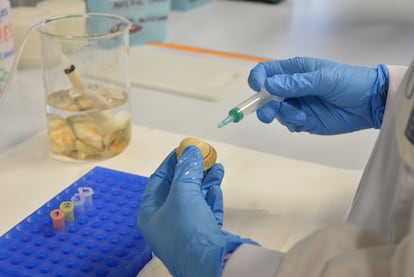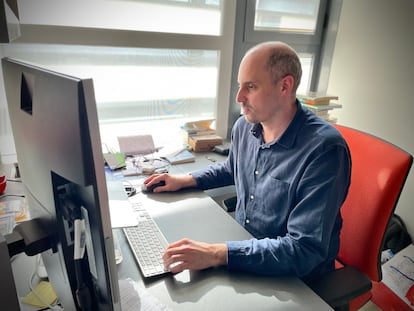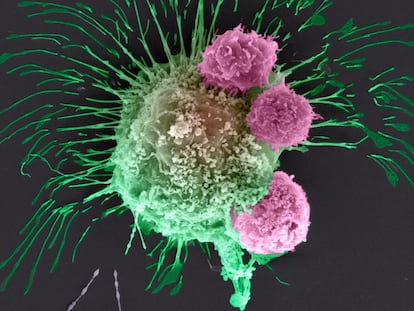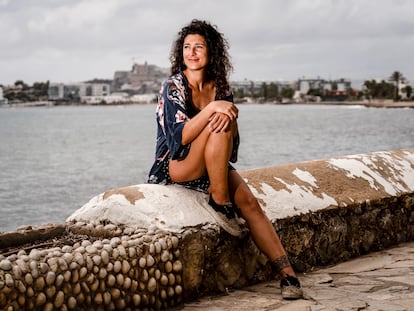Cockles that have transmissible leukemia shed light on unusual contagious cancer
There are over a dozen transmissible tumors in mollusks, the Tasmanian devil and even dogs, but cases in humans are extremely rare
Under extremely rare conditions, cancer can be contagious. Biologist José Tubío recalls the case of a German surgeon who got a small wound on his left hand while removing a malignant tumor. Five months later, the patient’s cancer had grown on one of the doctor’s fingers. In Japan, two children suffered lung tumors generated from uterine carcinoma cells their mothers had on the day they gave birth. According to estimates, only one in 500,000 mothers with cancer transmits it to their children through the placenta. But Tubío explains that transmissible cancer is much more common in mollusks. In a can of cockles, there can be several specimens with leukemia (they’re still as tasty and safe to consume). This isn’t a cancer that arises in each individual, but rather cancer cells from the same remote tumor that have been jumping from cockle to cockle in the sea for thousands of years. Tubío, a researcher from the University of Santiago de Compostela in Spain, believes that this phenomenon may help to understand metastasis, which is responsible for 90% of cancer deaths in people.
In 2014, Tubío was one of the scientists who discovered a new type of contagious facial tumor in the Tasmanian devil. As observed almost a decade earlier, the Australian carnivorous marsupial, which was popularized by Warner Bros. cartoons, was already threatened by another transmissible cancer. The discovery of a second type of contagious cancer suggests that transmissible tumors may occur in nature more frequently than previously thought. Tasmanian devils transmit cancer cells through contact, primarily in bites during fights or copulation. The cancer then grows and deforms the animal’s snout until it is unable to feed and dies.
Tubío’s team has scoured the European and Moroccan Atlantic coast searching for cockles with leukemia. The researchers sent them live via express mail or transported them themselves by plane or in the trunk of a car to their laboratory at the University of Santiago de Compostela (Spain). The group analyzed about 7,000 cockles, almost 6% of which had cancer. Their results were “a shock,” Tubío says. The genetic information of animals is grouped in packages, that is, their chromosomes. These mollusks usually have 38, but their cancer cells reach 350 chromosomes, which are very deteriorated. “In human tumors, you find totally aberrant sets of chromosomes, but the level we have seen in cockles is extremely unstable. How is it possible that a tumor can live for thousands of years with such tremendous chaos in its genome? It’s a new paradigm,” the biologist says.

The scientific community has already discovered 11 types of contagious cancer: eight in bivalve mollusks like clams, cockles and mussels; two in Tasmanian devils; and another one in dogs. Tubío has also investigated this canine tumor, which is transmitted through copulation and grows in the genital areas. The biologist emphasizes that these are cells from a specific dog that became cancerous about 8,000 years ago and have been multiplying and moving from individual to individual ever since.
Tubío believes that cockle cancer “is probably the oldest known transmissible cancer.” Published in the academic journal Nature Cancer, his study estimates that these tumors arose “centuries or millennia ago.” Biologist Michael Metzger’s research group at the Pacific Northwest Research Institute in Seattle, Washington, published a separate study that estimates that the New England clam’s cancer is at least 200 years old. “Both tumors are surely millennia old,” Tubío says. The researcher notes that cockle cancer cells are so different from normal ones that his team came to believe that this tumor came from an extinct species. “Ultimately, we concluded that it emerged in a cockle of the same species thousands of years ago. We have some estimates suggesting that this tumor is between 100,000 and half a million years old, but that requires more rigorous study,” he notes.
Biologists Alicia L. Bruzos and Seila Díaz spent months searching for cockles with leukemia on beaches with colleagues. Bruzos is used to strange looks when she tells people what she does for a living, but she counters with the names of scientists who have won the Nobel Prize in Medicine for their research on marine animals. Ukrainian Elie Metchnikoff received the 1908 prize for discovering phagocytosis—the process by which a white blood cell destroys a foreign substance—after pricking starfish larvae with thorns from a rose. British scientists Alan Hodgkin and Andrew Huxley revealed the electrical mechanisms of neurons by studying squid; they won the 1963 Nobel Prize as a result. And British researcher Tim Hunt discovered proteins that are essential for cell division in sea urchins. He received the 2001 prize.
Now at the University of Caen (France), Bruzos’s doctoral thesis in Santiago de Compostela studied cockles with leukemia. “I don’t want to say that this will be Nobel Prize-winning research or that studying cockle tumors is going to cure cancer, but there are many, many things that we know today that were discovered by researching animals or plants that are unusual,” she explains. “Contagious cancer is a cancer that can go from one individual to another individual. It sounds like science fiction, but, if we think about it, our society’s main problem with cancer today is metastasis. And metastasis occurs when one or more cells from the primary tumor acquire the ability to travel to other parts of the body. You quickly see the analogy. If we find out which molecular mechanisms allow a cell to leave one individual and reach another —in this case through the sea— it may help us come up with ideas for new strategies to try to cure a normal cancer’s metastasis,” says Bruzos.

Biochemist Óscar Fernández Capetillo studies the molecular intricacies that lead to cancer at the Spanish National Cancer Research Center (CNIO) in Madrid. “Science is fascinating if the question is interesting, even if it is asked in the case of crickets,” the specialist argues (he did not participate in the new research). “Exploring the genome of transmissible tumors is a very interesting exercise, which talks about the evolution of cancer and how a tumor that has been around for a long time eventually accumulates mutations that allow it to generate authentic chromosomal Frankensteins with a gigantic number of chromosomes,” he says. “This tumor emerged in a cockle, which passed it on to another cockle, which in turn passed it on to another cockle. It’s like a tumor that has had 1,000 lives.”
In his laboratory, Fernández Capetillo, the director of the CNIO’s Genomic Instability Group, has cancer cells from human tumors that have 150 chromosomes, as opposed to the usual 46. “I believe that the mechanisms that explain why a cockle genome’s changes so much are not going to be very different from why a human tumor cell’s genome changes so much. What happens in a cockle will almost certainly apply to the human genome,” he says.
José Tubío shares an anecdote from his childhood. When he was about five years old, he went with his father to illegally pick cockles in the Noia estuary, in A Coruña, Spain. “We took two huge bags. When we left the beach, the Civil Guard [police] was waiting for us,” he recalls. That bitter memory of doing something wrong stuck with Tubío. Almost four decades later, he won €1.5 million ($1,574,475) from the European Research Council to finance his studies. His team described the cockle’s reference genome and shed light on its contagious tumors, which will also help prevent the mass mortality events that the species experiences. “Who would have thought that 40 years later I would be able to make amends for that act of vandalism,” he enthuses.
Sign up for our weekly newsletter to get more English-language news coverage from EL PAÍS USA Edition
Tu suscripción se está usando en otro dispositivo
¿Quieres añadir otro usuario a tu suscripción?
Si continúas leyendo en este dispositivo, no se podrá leer en el otro.
FlechaTu suscripción se está usando en otro dispositivo y solo puedes acceder a EL PAÍS desde un dispositivo a la vez.
Si quieres compartir tu cuenta, cambia tu suscripción a la modalidad Premium, así podrás añadir otro usuario. Cada uno accederá con su propia cuenta de email, lo que os permitirá personalizar vuestra experiencia en EL PAÍS.
¿Tienes una suscripción de empresa? Accede aquí para contratar más cuentas.
En el caso de no saber quién está usando tu cuenta, te recomendamos cambiar tu contraseña aquí.
Si decides continuar compartiendo tu cuenta, este mensaje se mostrará en tu dispositivo y en el de la otra persona que está usando tu cuenta de forma indefinida, afectando a tu experiencia de lectura. Puedes consultar aquí los términos y condiciones de la suscripción digital.
More information
Archived In
Últimas noticias
Most viewed
- Sinaloa Cartel war is taking its toll on Los Chapitos
- Oona Chaplin: ‘I told James Cameron that I was living in a treehouse and starting a permaculture project with a friend’
- Reinhard Genzel, Nobel laureate in physics: ‘One-minute videos will never give you the truth’
- Why the price of coffee has skyrocketed: from Brazilian plantations to specialty coffee houses
- Silver prices are going crazy: This is what’s fueling the rally











































